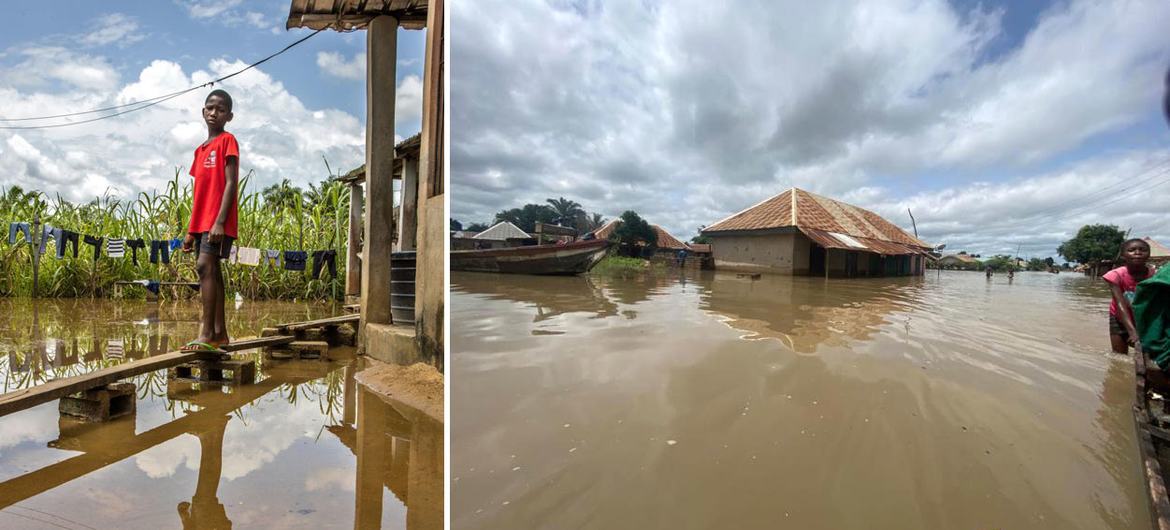621
Daniel Adaji, Abuja
The United Nations Environment Programme (UNEP) has issued a warning that inland river floods could place an additional 800,000 Nigerians at risk annually by 2030.
The warning was contained in data from UNEP’s Sub-programme 7, accessed by our reporter on Saturday.
Recall that Nigeria has long been recognised as highly vulnerable to climate change impacts due to a combination of political, geographic, and social factors.
The country ranked 160 out of 181 nations in the 2020 ND-GAIN Index, a measure of vulnerability to climate change and readiness to improve resilience.
The data highlights that climate change has already had severe consequences for Nigeria.
“Between 1960 and 2006, Nigeria experienced an increase of 0.8°C in its average annual temperature, with a steep increase occurring since 1980 and the greatest increase occurring in the northern region,” the report stated. In the same period, there was a “decrease in precipitation of 3.5 mm per month per decade.”
Climate projections suggest even more extreme conditions in the coming decades.
“The mean annual temperature is projected to increase by 1.1 to 2.5°C by 2060, with an extreme increase expected in the north of Nigeria. Increased variability in rainfall and extreme rainfall events are expected across most of the country, as well as a rise in sea level of 0.4 to 1.0 m by 2100, ” it added.
The report portrays Nigeria as one of the 10 most vulnerable countries globally to climate change and natural disasters. The devastating 2012 floods provide a grim precedent: “The 2012 floods affected 7 million people in 30 of the 36 states, displaced 2.3 million people, killed 363 people, and cost the economy an estimated USD 17.3 billion or 1.4% of the country’s GDP.”
According to UNEP, climate change trends will exacerbate flooding risks through “increased frequency and intensity of heavy rainfall events.”
Additionally, “the country’s eastern and central areas are expected to experience increased aridity and drought, with significant impacts for livelihoods and food security.”
The report also warns of worsening sea-level rise, which could impact southern cities like Lagos and coastal areas.
“By 2070, climate projections suggest that around 550,000 people in Nigeria could be affected by floods each year due to sea level rise. Furthermore, inland river floods are also likely to increase, placing an additional 800,000 people at risk each year by 2030.”
Climate change is expected to have severe effects on Nigeria’s water resources, agriculture, and health sectors.
“A considerable proportion of Nigeria’s population is already at risk of water stress, which is likely to be exacerbated by climate change. Increased rainfall variability will likely result in flooding in some humid areas in the south of the country, while a reduction in precipitation in the savannah north may result in drought and a decline in surface water resources,” it stated.
The rapid shrinking of Lake Chad exemplifies these climate-driven challenges.
“The rapid shrinking of Lake Chad from approximately 45,000 km² in 1960 to less than 3,000 km² in 2007 has been primarily attributed to changes in the climatic conditions in the region.”
Agriculture, a key sector for Nigeria’s economy and food security, is also at risk.
“Under a business-as-usual scenario, agricultural productivity in Nigeria could decline by between 10 to 25% by 2080. In some parts of the north, the decline in yield to rain-fed agriculture could be as high as 50%,” the report read.
The World Bank’s Climate Risk Profile (2021) further warns that “Increased levels of CO2 will lead to up to 17 per cent nutrient declines in rice, with increased rainfall variability and higher temperatures likely to further reduce the country’s rice yields.”
Without adequate climate adaptation measures, Nigeria could face dire economic consequences.
“A 2009 DFID study estimated that between 2-11% of the country’s GDP could have been lost by 2020. By 2050, climate change inaction could cost Nigeria between 6% to 30% of the country’s GDP, equivalent to a loss of US$100–460 billion,” it stated.
Given these alarming projections, the UNEP urges Nigeria to take urgent action to strengthen climate adaptation strategies and disaster risk management policies to mitigate the devastating effects of climate change.



